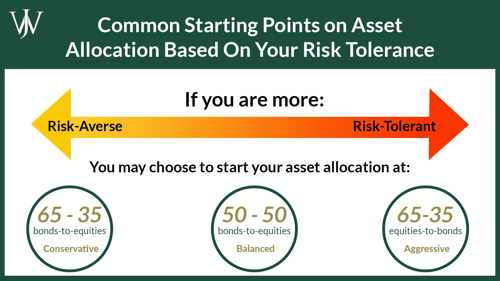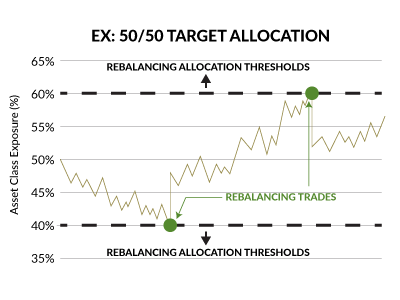After a lifetime of investing and saving, it can be a surreal adjustment to begin evaluating how to live off your assets. As you shift your investment strategy to accommodate the various costs of retirement, it’s important to take a look at your asset allocation to make sure you aren’t opening yourself to unexpected amounts of risk and to make sure you can live off your returns.
What is Asset Allocation?
Asset allocation is the mix of various investment vehicles (stocks, bonds, mutual funds, and cash) within your portfolio. This investment strategy lets you evaluate your own thresholds of how much risk you’ll take on for growth alongside how you want to diversify across asset classes and vehicles within your investable accounts.
Using this strategy, you can prioritize asset classes (for example, U.S. equities, emerging market debt, or REITs) rather than individual stocks (for example, Tesla, Zoom, or Peloton) to invest in while staying within your desired risk levels. For those looking to live off their investments in the future, determining the asset allocation you wish to adhere to can provide peace of mind as it becomes increasingly difficult to differentiate between the various stocks, bonds, and mutual funds options.
How Are Various Asset Classes Performing?
Watch Our Latest Market Update Here to Find Out >>
How Should Retirees Evaluate Their Asset Allocation
Asset allocation is a key driver of your investment performance so understanding how to leverage it effectively so you can live on those returns is essential. When looking at various asset allocations, there are a few common rules of thumb to determine the right one for you.
- Aggressive – If you’re looking for more growth in your investments and are willing to take on more risk, your asset allocation tends to be described as more aggressive. A good place to start for aggressive investors when determining the right asset allocation for them is a 65-35 equities-to-bonds ratio. From there, you can determine if you’d like to take on more or less risk by adding either equities or fixed income asset vehicles into your portfolio. One factor to consider is that while more aggressive portfolios with more equities can see aggressive growth, they are also significantly riskier and could stand to lose more in value if we enter a bear market. Another factor to consider is your time horizon, or the amount of time you have from today until when you’re looking to use the money in your portfolio. Oftentimes, if you have a longer time horizon, you can afford to take on a bit more risk, but that’s not always the case.
- Conservative – For those who are interested in growth but are more risk-averse and therefore tend to carry more fixed income in a portfolio, your asset allocation tends to be described as more conservative. For these investors, a good starting point is the opposite of the aggressive asset allocation – 65-35 bonds-to-equities. From there, you can determine if you’d rather carry more or less fixed income or equities in your portfolio to reach your goals. A conservative investing approach tends to be more common when the time horizon is shorter and the need for the money in the portfolio becomes more immediate. A key consideration for those looking to use a conservative asset allocation is that while this approach tends to be how people want to invest to avoid extra unnecessary risks, it may not offer them the growth needed within their time horizon to afford their desired lifestyle in retirement.
- Balanced – For those looking for a place to start that equalizes the two approaches above, we’d describe your asset allocation as balanced. A good place to start for a balanced asset allocation is 50-50 equities-to-bonds. From there, you can tweak and add either fixed income or equities until you reach the risk and growth thresholds you’re most comfortable with.

Determining the Right Asset Allocation for You
One of the common concerns we hear from clients is, “do I have enough to live comfortably in retirement?” As you begin budgeting and planning for the later stages of your life, there are numerous variables to consider.
Step 1: Understanding how much money you need for retirement
One of the most daunting aspects of retirement is estimating how much money you'll want for your retirement and setting up a savings goal to reach it. To establish a realistic retirement budget, we start by analyzing a prospective client's current spending. Understanding where you spend money today will help you and your advisor identify the things most important to you.
One of the biggest misconceptions is that you will spend less in retirement, but this is rarely the case. Even if your house is paid off and your children are finished with their education, grown-up, and married, you become accustomed to a particular lifestyle. Below are a few questions to consider when creating your retirement budget:
- HOME: What costs are associated with updating or remodeling your current home in preparation for retirement? Also, what additional costs may arise for new furniture purchases?
- SECOND HOME: Would you like a place to escape Houston's hot summers or a place for a family gathering spot?
- EDUCATION COSTS: Many retirees will plan on helping grandchildren with education costs such as private schooling and/or college. Do you have a plan in place for the next generation?
Saving for College is Different for High-Income Families
Learn More Here >>
- EDUCATION COSTS: Many retirees will plan on helping grandchildren with education costs such as private schooling and/or college. Do you have a plan in place for the next generation?
- VACATIONS: When you retire, you will have more time to vacation. Planning a larger travel budget when you first retire is realistic, especially if the travel budget includes family members other than you and your spouse. From time to time, retirees invite their children and spouses, grandchildren, parents, and in-laws along on vacation.
- ELDERLY SUPPORT OR MEDICAL COSTS: You may need to assist elderly parents or other family members during critical years. This could include incurring costs for proper medical care or assisted living costs, as well as travel costs to their hometown to assist them in day-to-day activities like paying bills or taking care of a home.
- AUTO BUDGET: Automobiles will likely need to be replaced in retirement. Oftentimes, we hear clients preparing to retire say that they just paid off their cars and they believe they're in good shape. But, the reality is there are always costs that creep up for automobile repairs, maintenance, and eventually replacement.
Step 2: Understand How Often You’ll Withdraw the Money (i.e. Determine Your Withdrawal Rate)
After you've decided your grand total needed for retirement and you understand what your options for investing are, it's important to determine how much you'll need on an annual basis. The withdrawal rate is the percentage of funds one removes from an account over a period of time. We typically recommend clients increase bond exposure based on the amount they expect to withdraw in a year.
While assessing withdrawal rate can be a helpful framework to build your asset allocation from, additional factors like the time horizon you have until your retirement, your unique tolerance to risk, and the intended purpose for your portfolio (liquid assets, education costs, healthcare, etc.) all play a role in determining what the right asset allocation for you is. It is imperative that, when adjusting your asset allocation based on your withdrawal rate and your preferred risk, you give your advisor enough time to rebalance your portfolio to the new asset allocation to help you reach your goals.
Step 3: Adjust for Your Desired Level of Risk
Using the rule of thumb above, you can set an initial target for your asset allocation. As we mentioned above, there are three common approaches to asset allocation: Aggressive, Balanced, and Conservative. Each of these has a different proportion of risk to reward and you can adjust in accordance to the amount of risk you’re willing to take on. The final step to leveraging these asset allocations is managing the risk associated with each of them.
Through being diversified and using a strategy known as Target Band Rebalancing, we help clients maintain their desired asset allocations and risk exposure, no matter what happens in the stock market.
- Diversification
Diversification of your investments allows you to reduce your exposure to specific types of risk. If your portfolio includes a disproportionate amount of one asset class or another, your exposure to these risk factors is amplified within these asset classes and their respective subclasses. For some, this is overexposure to their company's stock overweighting their portfolio, while for others this is an overexposure to equities with minimal fixed income to protect returns in a downturn. While many people believe that diversification is as simple as having both stocks and bonds in a portfolio, we believe in diversifying across asset classes for a breadth of coverage, and across many of those asset classes' subclasses for depth as well. - Target band rebalancing can help you stay within your preferred risk allowances
With our client’s portfolios, we like to implement a strategy known as strategic target band rebalancing that helps keep their portfolios within reach of their desired asset allocation at all times. As the markets run up or dip, the weight of holdings within a portfolio shifts in kind, which can alter the asset allocation within your portfolio. Target band rebalancing allows us to set up a threshold at a designated percentage above and below our desired allocations to signal a rebalance. When positions reach these thresholds, we: 1) Trim the profits to capitalize on a run-up, or 2) Buy recently-battered positions at a lowered cost to get back to the desired allocations.
When positions reach these thresholds, we: 1) Trim the profits to capitalize on a run-up, or 2) Buy recently-battered positions at a lowered cost to get back to the desired allocations.
Learn How To Use Target Band Rebalancing with Your Investments Here >>
We believe market volatility is becoming a new normal, so managing risk exposure is crucial. If you’re not keeping a close eye on your portfolio, you could be opening yourself up to an overexposure in equities or missing opportunities to buy.
There are a lot of factors involved when it comes to the shift from investing for growth to living off your investments. You want to get it right from the beginning. Get a second opinion from our experts who have helped hundreds of Houston’s energy executives develop the right asset allocation and investment strategy to seamlessly transition into their retirement and beyond.







